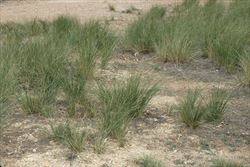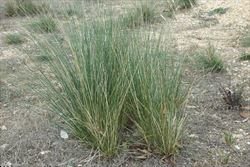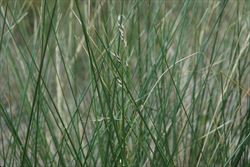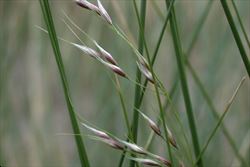Click on images to enlarge

infestation (Photo: Rob and Fiona Richardson)

habit (Photo: Rob and Fiona Richardson)

leaves and seed-head (Photo: Rob and Fiona Richardson)

close-up of flower spikelets (Photo: Rob and Fiona Richardson)
Scientific Name
Amelichloa caudata (Trin.) Arriaga & Barkworth
Synonyms
Achnatherum caudatum (Trin.) S.W.L. Jacobs & J. EverettStipa caudata Trin.
Family
Gramineae (South Australia)Poaceae (Queensland, New South Wales, the ACT, Victoria, Tasmania, Western Australia and the Northern Territory)
Common Names
broad kernel espartillo, broad-kernel espartillo, Chilean ricegrass, espartillo, puna grass, spear grass, speargrass
Origin
This grass is native to southern South America (i.e. Argentina, Chile and Uruguay).
Naturalised Distribution
Not yet widely naturalised, and currently found mostly in the sub-coastal districts of south-eastern Australia (i.e. in the inland parts of eastern New South Wales and central Victoria). It was first recorded in the Cootamundra district, in inland southern New South Wales, in 1959. It has since been recorded from the Deniliquin area, on the south-western plains, and in the Tamworth region in the north of the state. In Victoria it was first recorded from near Dunolly, to the south-west of Bendigo, in the central parts of the state. It has since been observed at several nearby locations including Castlemaine, Maryborough, Talbot and Clunes. It has also been recorded in the north of the state as well as in Coburg in the northern suburbs of Melbourne. A couple of localised populations have also been recently discovered in Tasmania (i.e. at the old Bridgewater railyards in the Brighton region in eastern Tasmania and on one property on Flinders Island in Bass Strait).
In other parts of the world it has also recently become naturalised in the north-western parts of the USA (i.e. in Oregon) and in New Zealand (i.e. at a single location at Bingley, near Amberley).
Habitat
Mainly a weed of temperate grasslands, particularly overgrazed pastures. Is also found growing in disturbed sites, waste areas, along roadsides and areas near waterways.
Habit
A densely tufted or tussock-forming, long-lived (i.e. perennial), grass usually growing 55-100 cm tall but occasionally reaching up to 1.5 m in height. It does not have any creeping underground stems (i.e. rhizomes) and has a fibrous root system.
Distinguishing Features
- a long-lived, tussock-forming, grass with upright stems that are usually ribbed.
- its leaves are very narrow (up to 70 cm long and only 1-2.5 mm wide) and strongly ribbed on both sides.
- its produces seeds with long awns in large elongated seed-heads at the top of the plant.
- its also produces seeds in small seed-heads held within the leaf sheaths at the base of the plant.
Stems and Leaves
The stems are upright (i.e. erect) and either rounded, slightly angled or strongly ribbed. There are usually 2-4 slightly swollen joints (i.e. nodes) along these stems.
The leaves are made up of a leaf sheath, which partially encloses the stem, and a spreading leaf blade. The lower leaf sheaths are tightly held (i.e. appressed) to the stems and sometimes enclose a small seed-head with a few seeds (i.e. axillary cleistogenes). These leaf sheaths are hairless (i.e. glabrous) except at the upper margins, which are somewhat hairy (i.e. pubescent). A tiny membrane-like structure (i.e. membranous ligule) is present where the leaf sheath joins the leaf blade. This ligule (0.1-0.5 mm long) also has a tuft of hairs on either side of it. The very narrow (i.e. linear or filiform) leaf blades (25-70 cm long and usually only 1 to 2.5 mm wide) are stiff and either flattened or tightly rolled (i.e. convoluted). They are usually strongly ribbed on both sides and have a sharply-pointed tip (i.e. acute apex).
Flowers and Fruit
Two types of seed-heads (i.e. inflorescences) are produced by this species. The more obvious seed-heads are elongated branched clusters borne at the top of the plant (i.e. terminal panicles). These seed-heads (15-45 cm long and 2-3 cm wide) bear numerous small flower spikelets (5-11 mm long), several of which are arranged along each of its many short branches. Each flower spikelet consists of a pair of bracts (i.e. glumes) and a tiny flower (i.e. floret). The floret has two floral bracts (i.e. palea and lemma), three stamens (about 3 mm long), and an ovary topped with a two-branched feathery stigma. Flowering begins in late spring and continues throughout the summer (i.e. from October to February).
The flower spikelets break up at maturity and two subtending bracts (i.e. glumes) remain on the seed-head (i.e. they are persistent). These bracts are elongated in shape (7-11 mm long) and have pointed tips (i.e. acuminate apices). The yellowish-brown coloured 'seeds' are relatively short and broad (4-6 mm long) with a hairy base (i.e. callus) and a bent and twisted awn (12-20 mm long). However, the actual seed itself (i.e. caryopsis or grain) is quite small (2-3 mm long and 1-1.4 mm wide) and is enclosed within the two tightly overlapping floral bracts (i.e. a palea and lemma).
A second type of seed-head (i.e. inflorescence) is produced within the lower leaf sheaths of the plant. It consists of several slightly larger flower spikelets (8-12 mm long) which produce self-pollinated seeds (i.e. axillary cleistogenes) that do not have awns (though they may have pointed tips).
Reproduction and Dispersal
This plant reproduces by two types of seeds (i.e. cross-pollinated seeds produced in terminal panicles and self-pollinated seeds produced inside the leaf sheaths at the base of the plant). Seeds usually germinate during autumn and the seedlings grow slowly over winter.
The cross-pollinated seeds are most-often dispersed after their awns become attached to animal hides, clothing or vehicles. Both seed types may also be spread in contaminated agricultural produce, by water (particularly during floods), by slashing or mowing, and by soil disturbance.
Environmental Impact
Broad kernel espartillo (Amelichloa caudata) is known to invade native grasslands, open forests, woodlands and riparian vegetation. It is initially often found as a weed of wasteland areas and roadsides, from where it invades adjacent pastures and temperate grasslands. It is one of eleven exotic stipoid grasses that are naturalised in Australia. These species, as a group, are considered to be a threat to nationally important remnant temperate grasslands.
While broad kernel espartillo (Amelichloa caudata) currently has a relatively limited distribution and impact, it is thought to have the potential to become much more widespread, and in one study it was found that this species had a potential distribution of about 13 million hectares in Australia. It is already a significant emerging problem in a number of Australian mainland locations, particularly in Victoria and New South Wales. In Victoria it is considered to have moderate to high ecological impacts and has been observed to invade riparian vegetation in some locations (i.e. along Edgars Creek in the northern suburbs of Melbourne and in central Victoria). In Tasmania, where it is only locally established in a few sites, it is seen as such a potential threat that it has been targeted for eradication by 2020.
Other Impacts
This species is also seen as a threat to agricultural practices, and in particular the pastoral industry. Run-down pastures are particularly vulnerable to invasion by broad kernel espartillo (Amelichloa caudata), and once it is established it can be very difficult to manage. In New South Wales it is also becoming a serious weed of pastures that are re-sown following cultivation. This species is a relatively poor fodder plant (i.e. it has a low palatability) and can therefore significantly reduce the productivity of pastures, but when there are no other pasture species present starving sheep and cattle will feed on young plants. In Tasmania its threat potential to grazing land is thought to be comparable with that of serrated tussock (Nassella trichotoma).
Legislation
This species is declared under legislation in the following states and territories:
- ACT: C1 - notifiable pest plant (a pest plant whose presence must be notified), and C4 - prohibited pest plant (a pest plant whose propagation and supply is prohibited). Note: This plant is declared under the name Achnatherum caudatum in the ACT.
- South Australia: 1N# - this species is a prohibited terrestrial plant and declared a Class 1c(i) weed. It is notifiable throughout the state and must be destroyed. Note: This plant is declared under the name Achnatherum caudatum in South Australia.
- Tasmania: D - the importation or sale of this species is prohibited and measures to reduce its population in an area, eradicate it from an area, or restrict it to a particular area may be required. Note: This plant is declared under the name Achnatherum caudatum in Tasmania.
- Western Australia: Prohibited - on the prohibited list and not permitted entry into the state.
Similar Species
Broad kernel espartillo (Amelichloa caudata) is very similar to narrow kernel espartillo (Amelichloa brachychaeta) and these species can be distinguished by the following differences:
- broad kernel espartillo (Amelichloa caudata) has a partially hairy (i.e. pubescent) seed coat, and a grain that is relatively broad (2-3 mm long and 1-1.4 mm wide). Its stem seeds (i.e. cleistogenes) are only produced in the lower leaf sheaths.
- narrow kernel espartillo (Amelichloa brachychaeta) has a totally hairy (i.e. pubescent) seed coat, and a grain that is relatively narrow (2-3 mm long and 0.9-1.0 mm wide). Its stem seeds (i.e. cleistogenes) are produced in the upper and lower leaf sheaths.
Broad kernel espartillo (Amelichloa caudata) is also relatively similar to several of the native speargrasses (Austrostipa spp.) and other introduced stipoid grasses such as Chilean needlegrass (Nassella neesiana), serrated tussock (Nassella trichotoma), Mexican feathergrass (Nassella tenuissima), lobed needlegrass (Nassella charruana), cane needlegrass (Nassella hyalina), Texas needlegrass (Nassella leucotricha), short-spined needlegrass (Nassella megapotamia), Uruguayan ricegrass (Piptochaetium montevidense) and plumerillo (Jarava plumosa).
However, broad kernel espartillo (Amelichloa caudata) can be distinguished from the native speargrasses (Austrostipa spp.) by its membranous ligules; from Mexican feathergrass (Nassella tenuissima) and serrated tussock (Nassella trichotoma) by its broader leaves (1-2.5 mm wide compared to less than 1 mm across); from the needlegrasses (Nassella neesiana, Nassella charruana, Nassella hyalina, Nassella leucotricha and Nassella megapotamia) by not having a collar-like structure (i.e. corona) where the seed and awn meet; from plumerillo (Jarava plumosa) by not having a 'plume' of hairs on the lower part of the awn; and from Uruguayan ricegrass (Piptochaetium montevidense) by its slightly elongated seed (i.e. the grain of Piptochaetium montevidense is rounded in shape).
Note: This page only covers those species that are commonly confused with broad kernel espartillo (Amelichloa caudata). For a more in-depth key to all of the grasses present in Australia, see the AusGrass: Grasses of Australia CD-ROM or Flora of Australia, Volumes 43 and 44.

